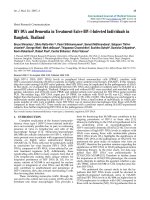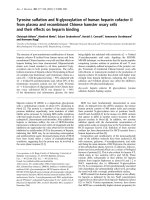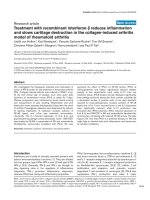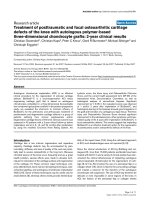Báo cáo y học: " Treatment outcomes and plasma level of ritonavir-boosted lopinavir monotherapy among HIV-infected patients who had NRTI and NNRTI failure" docx
Bạn đang xem bản rút gọn của tài liệu. Xem và tải ngay bản đầy đủ của tài liệu tại đây (255.92 KB, 5 trang )
AIDS Research and Therapy
Research
Treatment outcomes and plasma level of ritonavir-boosted
lopinavir monotherapy among HIV-infected patients who had
NRTI and NNRTI failure
Weerawat Manosuthi*
1,2
, Sasisopin Kiertiburanakul
2
,
Wannarat Amornnimit
1
, Wisit Prasithsirikul
1
, Supeda Thongyen
1
,
Samruay Nilkamhang
1
,KiatRuxrungtham
3,4
and Somnuek Sungkanuparph
2
Address:
1
Bamrasnaradura Infectious Diseases Institute, Ministry of Public Health, Nonthaburi, 11000, Thailand,
2
Facu lty of Medicine
Ramathibodi Hospita l, Mahidol University, Bangkok, Thailand,
3
The HIV Netherlands-Australia-Thailand (HIV-NAT) Research Collaboration,
Thai Red Cross AIDS Research Centre, Bangkok , Thailand and
4
Department of Medic ine, Faculty of Medicine, Chulalongkorn Univer sity,
Bangkok, Thailand
E-mail: Weerawat Manosuthi* - om; Sasiso pin Kiertiburanakul - ;
Wannarat Amornnimit - m; Wisit Prasithsirikul - ; Supeda Thongye n - ;
Samruay Nilkamhang - ; Kiat Ruxrungtham - ;
Somnuek Sungkanuparph - ssungkanuparp
*Corresponding author
Published: 23 December 2009 Received: 30 October 2009
AIDS Research and Therapy 2009, 6:30 doi: 10.1186/1742-6405-6-30
Accepted: 23 December 2009
This article is available from: http: //www.aidsrestherapy.com/content/6/1/30
© 2009 Manosuthi et al; licensee BioMed Central Ltd.
This is an Open Access article distributed under the terms of the Creative Commons Attribution License (
s/by/2.0),
which permits unrestricted use, distri bution, and reproduction in any medium, provided the original work is properly cited.
Abstract
Background: Different strategies of ritonavir-boosted lopinavir monotherapy have been
explored; however, data regarding salvage therapy among HIV-infected patients who failed
nucleoside reverse transcriptase inhibitor (NRTI) and non-nucl eoside reverse t ranscriptase
inhibitor (NNRTI) is still limited.
Methods: A prospective study was conducted among HIV-infected patients who failed NNRTI-
based antiretroviral therapy with M184V, TAMs, and NNRTI mutations, and were na ïve to
protease inhibitor. LPV/r at 400/100 mg and lamivudine 150 mg were given twice daily. CD4 and
HIV-1 RNA were monitored at week 0, 12, 24, and 48. L PV Cmin was assayed for the first
14 patients using HPLC.
Results: There were 40 patients with a mean age of 37 years and 70% were male. Median (IQR)
baseline CD4 was 123 (37-245) cells/mm
3
and median (IQR) HIV-1 RNA was 55,800 (9,670 -
100,000) co pies/mL. By intend-to-treat analysis, 30 (75 %) and 24 (60 %) patients achieved HIV-1
RNAat<400and<50copies/mL,respectively.Inas-treated analysis, the corresponding rates were
29 (83%) and 23 (67%), respectively. Lo w-level viral rebound was f ound in 6 ( 15%) patients at w eek
48. Medians CD4 at week 12, 24, 36 and 48 were 249, 283, 307, and 351 cells/mm
3
and significantly
changed from baseline (all, P < 0.05). At 6 and 12 weeks, median (min-max) LPV Cmin was 6.52
(1.62-11.64) mg/L and 5.79 (0.75-16.31) mg/L, r espectively. There were increments of mean total
cholesterol and triglyceride at 48 weeks from baseline (P <0.05).
Conclusion: LPV/r monotherapy with recycled lamivudine can maintain virological suppression in
a substantial proportion of patients failing NNRTI-based regimen and provides adequate plasma
concentrations of LPV although the incidence of low-level viremia is relatively high.
Page 1 of 5
(page number not for citation purposes)
BioMed Central
Open Access
Introduction
Currently, non-nucleoside reverse transcriptase inhibitor
(NNRTI)-based highly active antiretroviral therapy
(HAART) is widely p rescribed as an initial therapy for
treatment naïve HIV-infected patients, particularly in
many resource-constrained countries [1]. However, in
patients who have delayed detection of treatment failure
in this setting, the virus is often resistant to most existing
nucleoside reverse transcriptase inhibitors (NRTIs) and
NNRTIs even failing from the first regimen [2]. As a
consequence, constructing the potent salvage regimens
that combined 2 or 3 fully active drugs from existing drug
classes is often impossible in many resource-constrained
countries wher e new agents, such as integrase inh ibito r
and chemokine receptor antagonist, are neither available
nor affordable. Nevertheless, the goal of attaining
undetectab le plasma HIV-1 RNA is remain mandatory
[3]. To date, several clinical studies derived from the
western countries that included 2 or more active drugs
clearly demonstrate effective therapeutic strategies for
antiretroviral (ARV) -experienced HIV-1 infected patients
[4,5]. Hence, using ritonavir-boosted protease inhibitor
in a salvage therapy was considered to be an option in the
resource-constrained countries and the limitations of
remaining active NRTIs usually lead to ritonavir-boosted
protease inhibitor monotherapy as a salvage regimen.
Among several previous reports using ritonavir-boosted
protease inhibitor, ritonavir-boosted lopinavir mono-
therapy has been extensively studied so far [6]. Different
strategies of ritonavir-boosted lopinavir monotherapy
have been explored; however, most related c linical trials
studied this regimen as either a treatment simplification
strategy or induction therapy in treatment-naïve patients
[6]. A strategy to use ritonavir-boosted lopinavir mono-
therapy as a salvage regimen is not available. On the
other hand, previous studies showed that continuation
of lamivudine after emerging of the M184V mutation
had somewhat benefit on immunological response and
clinical progression in patients who had limited options
of salvage regimens [7]. Moreover, there is neither
additional any other mutation nor increase resistance
to other antiretroviral drugs. Thus, this is the reason why
we added lamivudine to decrease viral fitness in the
study regimen. The objective of this study was to assess
48-week treatment responses, tolerability, and steady-
state minimum plasma concentrations of ritonavir-
boosted lopinavir monotherapy for salvage therapy in
HIV-1 infected patients who f ailed antiretroviral regi-
mens containing NRTI and NNRTI.
Materials and methods
All patients followed at Bamra snaradura Infectious
Diseases Institute, Ministry of Public Health, Thailand,
between April 2007 and February 2008 were evaluated
for antiretroviral therapy failure based on guidelines for
antiretroviral therapy of the Thai AIDS Society, which
define failure as viral load >1,000 copies/mL after 6
months of receiving treatment or a rebound of viral load
to >1,000 copies/mL in any duration after undetectable
viral l oad [8]. Inclusion criteria were as follows: (1) HIV-1
infected patients >18 years of age, (2) failed NNRTI-based
antiretroviral therapy with M184V, thymidine analogue
mutations (TAMs) and NNRTI-associated mutations and
(3) had plasma HIV-1 RNA >1,000 copies/mL. The
patients were excluded if they had a history of exposure
to protease inhibitor or receipt a medication that has
drug-drug interactions with lopinavir. All patients were
followed until 48 weeks of treatment. Ritonavir-boosted
lopinavir in soft gel formulation at 400/100 mg and
lamivudine at 150 mg were given twice daily. Clinical
characteristics and findings from physical examinations
were recorded for each patient. Patients were assessed as
well as CD4 cell counts (flow cytometr y) and plasma
HIV-1 RNA (Roche Amplicor, version 1.5) at follow-up
visits at weeks 0, 12, 24, and 48. The lower limit of
detection for the HIV-1 RNA level is 50 copies/mL.
Virological failure was defined as either a plasma HIV-1
RNA level >1,000 copies/mL after having a previously
undetectable value. Serum was obtained at 24 hours after
dosing to assay lopinavir concentration for the first 14
patients at the HIV Netherlands-Australia-Thailand Clin-
ical Research Laboratory , which is located at the
Chulalongkorn Medical Research Center (Bangkok), by
high-performance liquid chromatography. This assay was
performed in accordance with the protocol developed by
the Department of Clinical Pharmacology at the Uni-
versity Medical Centre Nijmegen (Nijmegen, the Nether-
lands) [9].
All analyses were performed using SPSS, version 14.0.
Mean values (± standard devia tions) or median values
(with interquartile ranges; IQRs) and frequency were
used to describe the patients’ characteristics for contin-
uous and categorical data, respectively. The proportion
of patients with plasma HIV-1 RNA <50 copies/mL after
48 weeks of ART were analyzed as intend-to-treat and as-
treated. Paired t-test was used to compare parameters
between time points. P values < 0.05 were considered to
be statistically significant. The institutional ethics com-
mittees of Bamrasnaradura Infectious Diseases Institute
and Ministry of Public Health approved the study. All
patients signed the inform consent.
Results
Table 1 summarizes subject characteristics and labora-
tory parameters. There were 40 patients with 70% male
and a mean age of 37 years. The frequencies of
AIDS Research and Therapy 2009, 6:30 />Page 2 of 5
(page number not for citation purposes)
thymidine analogue associated mutations (TAMs) were
17 (4 3%) D67N, 16 (40%) T215FY, 8 (20%) M41L,
6 (15%) K60R, 6 (15%) L 210W, 2 (5%) K219Q. Q151M
and L74V were found in 7 (18%) and 2 (5%),
respectively. The prevalence of patients with ≥1major
mutation conferring drug resistance to NNRTIs was
100%.
The proportion of patients who had different stratum of
plasma HIV-1 RNA at weeks 48 of treatment by intend-
to-treat analysis was displayed in figure 1. By intend-to-
treat analysis, 33 (83%), 30 (75%) and 24 (60%)
patients achieved plasma HIV-1 RNA at <1000, <400 and
<50 copies/mL after 48 weeks, respectively. In as-treated
analysis (excluded dropped out, study drug discontinua-
tion by any reason and transferred), the corresponding
rates were 33 (94%), 29 (83%) and 23 (67%),
respectively. Low-level viral rebound, defined as having
plasma HIV-1 RNA between 50 and 400 copies/mL after
having <50 copies/mL during the follow-up period, was
found in 6 (15%) p atients at week 48. Nine of 11
patients with plasma HIV-1 RNA >50 copies/mL had
value between 50 and 1,000 copies/mL. In 11 patients,
all but two had never achieved plasma HIV-1 RNA <50
copies during the study period. Two remaining patients
developed virological rebound at week 48. No major
PRAM was found in 2 patients who had virological
rebound above 1000 copies/mL. Means CD4 cell counts
changes at weeks 12, 24, 36 and 48 were shown in
Figure 2. These measures significantly changed from
baseline (all P values < 0.05). At 6 and 12 weeks of
treatment, median (min-max) lopinavir minimum con-
centrations were 6.52 (1.62-11.64) mg/L and 5.79 (0 .75-
16.31) mg/L, respectively. All but one patient achieved
lopinavir minimum con centrations greater than the
recommended minimum concentration that was 1 mg/
L. With regard to adverse reactions, 1 patient discon-
tinued ritonavir-boosted lopinavir due to diarrhea after
the first 2 weeks of ritonavir-boosted lopinavir treat-
ment. Compared measu res at week 48 to baseline values,
there were increments of mean total cholesterol (206 mg/dL
vs. 170 mg/dL, P < 0.05) and mean triglyceride (348 mg/dL
vs. 216 m g/dL; P < 0.05). Eight patients and 24 patients had
total cholesterol to HDL ratio ≥6.5 and ≥4atweek48,
respectively. Three patients needed to initiate anti-lipid
Table 1: Baseline characteristics of 40 HIV-infected patients
Baseline characteristics Number (%), n = 40
Demographics
Age, mean ± SD, years 37.1 ± 8.0
Male gender, number (%) 28 (70)
Body weight, mean ± SD, Kilograms 57 ± 21
Body mass index, mean ± SD 22.7 ± 4.6
Duration of previous ART, median (IQR),
years
2.1 (0.8-3.2)
Laboratory parameters
CD4 cell counts at virological failure, mean ±
SD, cells/mm
3
144 ± 124
Percentage of CD4 cell at virological failure,
mean ± SD, %
7.7 ± 5.1
Plasma HIV-1 RNA at virological failure,
median (IQR), copies/mL
55,800
(9,670-100,000)
Log, copies/mL 4.8 (4.0-5.0)
Total cholesterol, mean ± SD, mg/dL 165 ± 42
HDL choleterol, mean ± SD, mg/dL 41 ± 30
Triglyceride, mean ± SD, mg/dL 172 ± 117
Total cholesterol:HDL ratio ≥6.5, number (%) 2 (5)
Fasting blood sugar, mean ± SD, mg% 100 ± 27
Patients with ≥3 TAMs, number (%) 13 (32.5%)
Patients with Q151M, number (%) 7 (18%)
Figure 1
Percentage of patients who had different stratum o f
plasma HIV-1 RNA at weeks 4 8 of treatment by
intend-to-treat analysis.
Figure 2
Means and its standard deviations of CD4 cell counts
changes at weeks 12, 24, 36 and 48 of treatment.
AIDS Research and Therapy 2009, 6:30 />Page 3 of 5
(page number not for citation purposes)
agents during the follow-up period. There was an increment
of fasting blood sugar from week 48 to baseline value
(110 mg% vs. 100 mg%, P = 0.210). Two patients were
receiving oral hypoglycemic agents at enrollment and
another two patients had started oral hypoglycemic agents
during the follow-up period.
Discussion
As NNRTI-based HAART regimen is extensively pre -
scribed in many resource-limited countries and due to
delayed detection of virological failure from lacking the
effective monitor ing tools and/or inadequate infrastruc-
ture in the real-life practice, extensive NRTI and NNRTI-
associated mutations could be problematic in those area.
To the best of our knowledge, this is the first clinical trial
that has shown clinical outcome and pharmacokinetic
measures of ritonavir-boosted lopinavir together for the
patients experienced with NRTIs and NNRTIs although it
was conducted in a small study. Our data indicate that
ritonavir-boosted lopinavir monotherapy combined
with recycled lamivudine can maintain virological
suppression in a substantial p roportion of patients
who were failing NNRTI-based regimens with M184V,
TAMs and NNRTI mutations but were naïve to protease
inhibitor. Using intend-to-treat analysis, 60% of patients
reached the virological success, i.e., plasma HIV-1 RNA
<50 copies/mL, after 48 weeks of treatment. This result is
relatively consistent with a recent report that involved
antiretroviral-naïve patients by Delfraissy and colleagues
[10]. Of 84 patients in ritonavir-boosted lopinavir
monotherapy arm, 67% and 79% had achieved unde-
tectable plasma HIV-1 RNA by intend-to-treat and as-
treated analysis, respectively. In addition, Gathe and
colleagues also reported 77% of antiretroviral naïve
patients who were received treatment with ritonavir-
boosted lopinavir had undetectable plasma HIV-1 RNA
[11]. Regarding immu nol ogical res ponse , a higher C D4
cell count while receiving antiretroviral treatment
gained, a lower risk for AIDS-related events was
associated [12,13]. The presen t study reveal s that
ritonavir-boosted lopinavir showed a grea t pe rformance
on the immunological res ponse after 48 weeks of
treatment. A previous study showed that a regimen of
ritonavir-boosted lopinavir plus 2 NNRTIs had a greater
CD4 cell count response when compared with efavirenz
plus 2 NRTIs [14].
Interestingly, 15% of our patients had low level viremia.
This number is considered to be a significant proportion.
Of this proportion, 5% achieved undetectable plasma
HIV-1 RNA and 10% still had low level viremia at 72
weeks (data not shown). One possible explanation is the
lack of viral suppression in some compartments, such as
genital secretion and cerebrospinal fluid [15]. Another
previous proposed explanation is an alternative pathway
of protease inhibitor resistance facilitated by the absence
of the NRTI drugs, different HIV subtypes influence on
polymorphisms, and a non-adherence issue [16,17].
There was an increasing risk for virological failure in
patients with suboptimal adherence. The current guide-
lines from Department of Health and Human Services
(DHHS) suggested minimum target for lopinavir at
>1 mg/L [5]. Therefore, almost all of our patients had
their minimum concentration levels exceed the target
cut-off value. However, a single therapeutic drug
monitoring cannot exclude non-adherence, long-term
follow-up is therefore warranted.
Regarding adverse reactions, the most commonly
reported side effect associated with lopinavir/ritonavir
is mild to moderate diarrhea [18,19]. In addition, nausea
and vomiting, changes in blood lipid levels, elevated
transaminase levels and altered blood glucose profiles
also have been widely reported [19]. One of our patients
needed to discontinue ritonavir-boosted lopinavir due to
gastro-intestinal adverse event. Lopinavir/ritonavir soft
gel capsules had been used in the present study instead
of new lopinavir/ritonavir tablet because tablet formula-
tion had not been available in the country during the
study period. The lopinavir/ritonavir tablet formulation
could lower the rate of adverse gastro-intestinal symp-
toms associated with the soft-gel capsules. Although this
study was not designed to directly assess metabolic
complication, it could r evealed a great impact of
ritonavir-boosted lopinavir on serum lipid parameters,
included total cholesterol, LDL-cholesterol, triglyceride
and total cholesterol to HDL-chol esterol ratio, at 48
weeks of treatment. Likewise, a proportion of patients
had total cholesterol to HDL-cholesterol ratio above cut-
off value; i.e. ≥4, that related to high risk of coronary
heart disease [20,21].
In treatment-experienced patients failing NNRTI-based
regimens with limited NRTI options, switching to at least
2 fully active drugs to an optimized antiretroviral
regimen is principally the best strategy so far. In patients
with earlier first-line treatment failure and have devel-
oped either only M184V or with few TAMs, the option of
NRTI backbone i s s till not limited. In th ese cas es, there is
a possibility to include 1 or 2 active NRTI drugs in
combination with a new drug class, such as PIs, to assure
the effectiveness of the regimen. Thus in settings where
other new ARV classes beside PIs cannot be assessable,
early detect virological failure is crucial to preserve the
NRTI backbone. While waiting for a randomized control
trial to prove HIV monotherapy with ritonavir-boosted
protease inhib itor in these particular pa tients , the
present data provide support to physicians currently
facing choices of salvage regimen options in many
AIDS Research and Therapy 2009, 6:30 />Page 4 of 5
(page number not for citation purposes)
resource-constrained countries. Ritonavir-boosted lopi-
navir combined with recycled lamivudine to decrease
viral fitness can maintain virological suppression in a
substantial proportion of patients failing NRTI and
NNRTI with M184V and provides adequate plasma
concentrations of lopinavir although incidence of low-
level viremia is relatively high. A further larger study
would be required to assess the risk and benefit of this
proposed strategic treatment in the resource-constrained
settings.
Competing interests
The authors declare that they have no competing
interests.
Authors’ contributions
WM participated in the design of the study, statistical
analysis and draft the manuscript. SK, WA, WP, ST, KR
and SS participated in the design of the study and draft
the manuscript. SN participated in the design of the
study. All authors read and approved the final manu-
script.
Funding Statement
This study was supported by research grants from
Bamrasnaradura Infectious Diseases Institute, Thailand.
Acknowledgements
The authors wish to thank all the patients who participated in this study.
The abstract of this study is accepted to present in the 12th European
AIDS Conference, PE 7.9/14.
References
1. Scaling up Antiretroviral The rapy in Resource-limite d
Settings: Treatment Guidelines for a public Health
Approach. Geneva : Joint United Nations Programme on HIV/
AIDS (UNAIDS) and World Health Organization (WHO); 2006
revision.
2. Sungkanuparph S, Manosuthi W, Kiertiburanakul S, Piyavong B,
Chu mpathat N and Chantratita W: Options for a second-line
antiretroviral regimen for HIV type 1-infected patients
whose initial regimen of a fixed-dose combination of
stavudine, lamivudine, and nevirapin e fails. Clin Infect Dis
2007, 44(3):447–452.
3. Hirsch MS, Gunthard HF, Schapiro JM, Brun-Vezinet F, Clotet B,
Hammer SM, Johnson VA, Kuritzkes DR, Mellors JW and Pillay D,
et al: Antiretroviral drug resistance testin g in adult HIV-1
infection: 2008 recommendations of an International AIDS
Society-USA panel. Clin Infect Dis 2008, 47(2):266– 285.
4. Hammer SM, Saag MS, Schechter M, Montaner JS, Schooley RT,
Jacobsen DM, Tho mpson M A, Car pent er CC , Fi schl MA and
Gazzard BG, et al: Treatment for adult HIV infection: 2006
recommendations of the International AIDS Society-USA
panel. JAMA 2006, 296(7):827–843.
5. Guidelines for the Use of Antiretroviral Agents in HIV-1-
Infected Adu lts and Adolescents. U. S. Department of
Health and Human Servic es (DHHS).
.
6. Bierman WF, van Agtma el MA, Nijhuis M, Danner SA and
Boucher CA: HIV monotherapy with ritonavir-boosted
protease inhibitors: a systematic review. AIDS 2009, 23(3):
279–291.
7. Castagna A, Danise A, Menzo S, Galli L, Gianotti N, Carini E, Boeri E,
Galli A, Cernuschi M and Hasson H, et al: Lamivudine mono -
therapy in HIV-1-infected patients harbouring a lamivudine-
resistant virus: a randomized pilot study (E-184V study).
AIDS 2006, 20(6):795–803.
8. Sungkanuparph S, Anekthananon T, Hiransuthikul N,
Bowonwatanuwong C, Supparatpinyo K, Mootsikapun P,
Chetchotisakd P, Kiertiburanak ul S, Tansuphaswadikul S and
Buppanharun W, et al: Guidelines for antiretroviral therapy
in HIV-1 infect ed adults and adolescents: the recommenda-
tions of the Thai AIDS Society (TAS) 2008. J Med Assoc Thai
2008, 91(12):1925–1935.
9. Droste JA, Verweij-Van Wissen CP and Burg er DM: Simultaneous
determination of the HIV drugs indinavir, amprenavir,
saquinavir, ritonavir, lopinavir, nelfinavir, the nelfinavir
hydroxymetabolite M8, and nevirapine in human plasma
by reversed-phase high-performance liquid chromatogra-
phy. Ther Drug Monit 2003, 25(3):393–399.
10. Delfraissy JF, Fla ndre P, Delaugerre C, Ghosn J, Horban A,
Girard PM, Norton M, Rouzioux C, Taburet AM an d Cohen-
Codar I, et al: Lopinavir/ritonavir monotherapy or plus
zidovudine and lamivudine in antiretroviral-naive HIV-
infected patients. AIDS 2008, 22(3):385–393.
11. Gathe J, da Silva BA, Cohen DE, Loutfy MR, Podzamczer D, Rubio R,
Gibbs S, Marsh T, Naylor C and Fredrick L, et al: A once-daily
lopinavir/ritonavir-based regimen is noninfe rior to twice-
daily dosing an d results in similar safety and tolerability in
antiretroviral-naive subjects through 48 weeks. JAcquir
Immune Defic Syndr 2009, 50(5):474–481.
12. Loutfy MR, Walmsley SL, Mullin CM, Perez G and Neaton JD: CD4
(+) cell count increase predicts clinical benefits in p atients
with advance d HIV disease and persistent viremia after 1
yea r of combination antiretroviral therapy. JInfectDis2005,
192(8):1407–1411.
13. Moore DM, Hogg RS, Chan K, Tyndall M, Yip B and Montaner JS:
Disease progression in patients with virological suppression
in response to HAART is associated with the degree of
immunological response. AIDS 2006, 20(3):371–377.
14. Riddler SA, Haubrich R, DiRienzo AG, Peeples L, Powderly WG,
Klingman KL, Garren KW, George T, Rooney JF and Brizz B, et al:
Class-sparing regimens for initial treatment of HIV-1
infection. N Engl J Med 2008, 358(20):2095–2106.
15. Vernazza P, Daneel S, Schiffer V, Decosterd L, Fierz W, Klimkait T,
Hoffmann M and Hirschel B: Theroleofcompartment
penetration in PI-monotherapy: the Atazanavir-Ritonavir
Monomaintenance (ATARITMO) Trial. AIDS 2007, 21(10):
1309–1315.
16. Nij huis M, van Maarseveen NM, Verheyen J and Boucher CA: Novel
mechanis ms of HIV proteas e inhibitor resistance. Curr Opin
HIV AIDS 2008, 3(6):627–632.
17. Atkinson MJ and Petrozzino JJ: An Evidence-Based Review of
Treatment-Related Determinants of Patients’ Nonadher-
ence to HIV Medications. AIDS Patient Care STDS 2009, 23(11):
903–14.
18. Kaplan SS and Hicks CB: Safety and antiviral activi ty of
lopinavir/ritonavir-based therapy in human immunodefi-
ciency virus type 1 (HIV-1) infection. JAntimicrobChemother
2005, 56(2):273–276.
19. Cvetkovic RS and Goa KL: Lopinavir/ritonavir: a review of its
use in the management of HIV infection. Drugs 2003, 63(8):
769–802.
20. Scranton R, Sesso HD, Stampfer MJ, Leve nson JW, Buring JE and
Gaziano JM: Predictors of 14- year c hanges in the total
cholesterol to high-density lipoprotein cholesterol ratio in
men. Am Hear t J 2004, 147(6):1033–1038 .
21. Kos uge M, Kimura K, Ishikawa T, Shimizu T, Sugano T, Sumita S,
Hibi K, Takamura T, Toda N and Kanna M, et al: Differ ent clinical
and coronary angiographic findings according to ratios of
total cholesterol to high-density lipoprotein chole sterol
during the acute phase of myocardial infar ction. JCardiol
2004, 43(6):251–258.
AIDS Research and Therapy 2009, 6:30 />Page 5 of 5
(page number not for citation purposes)









